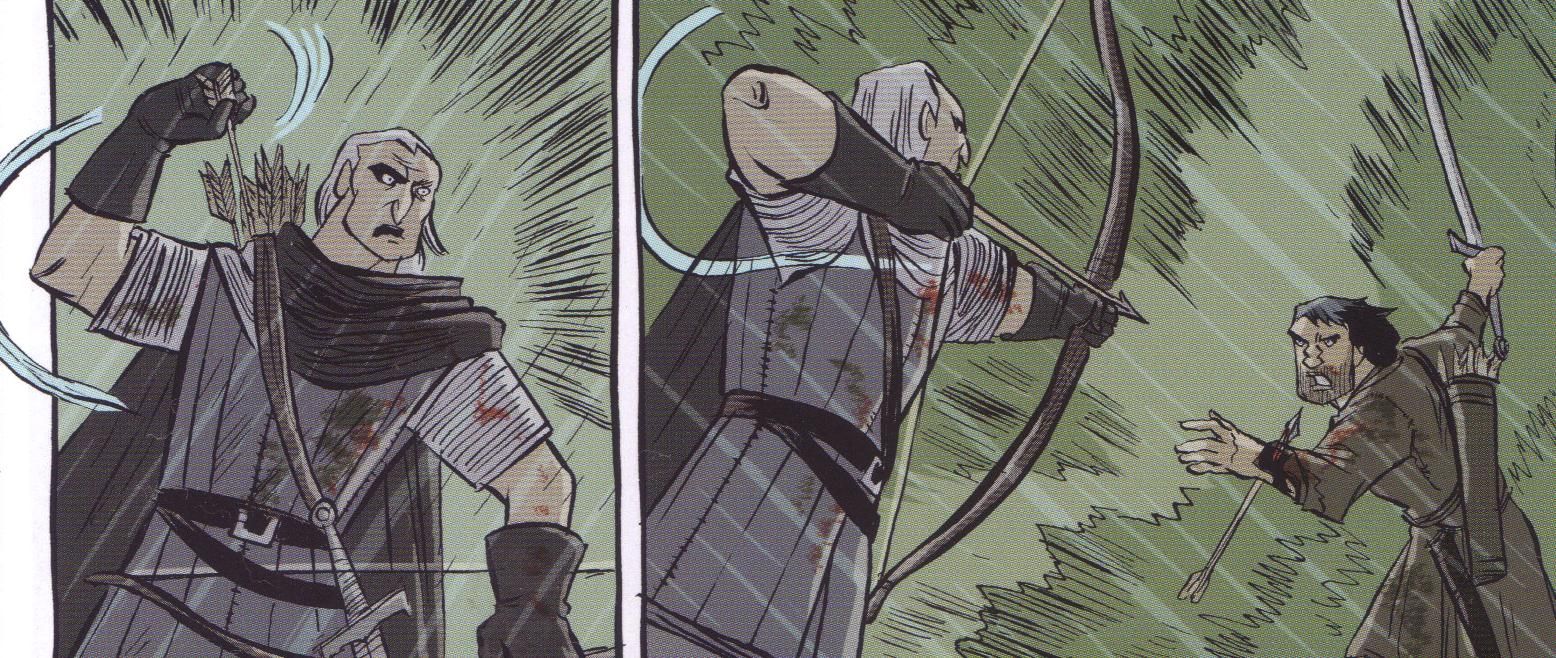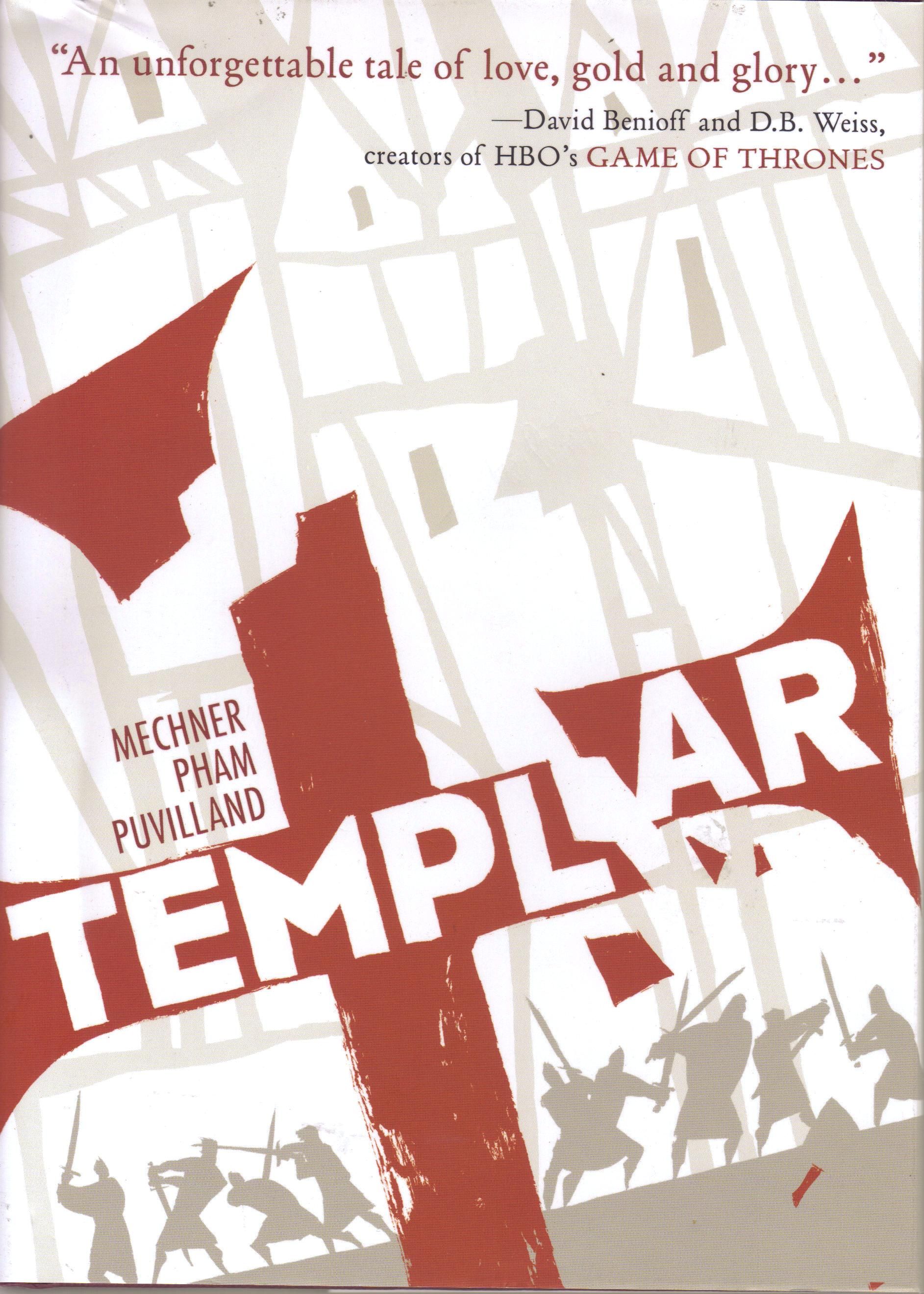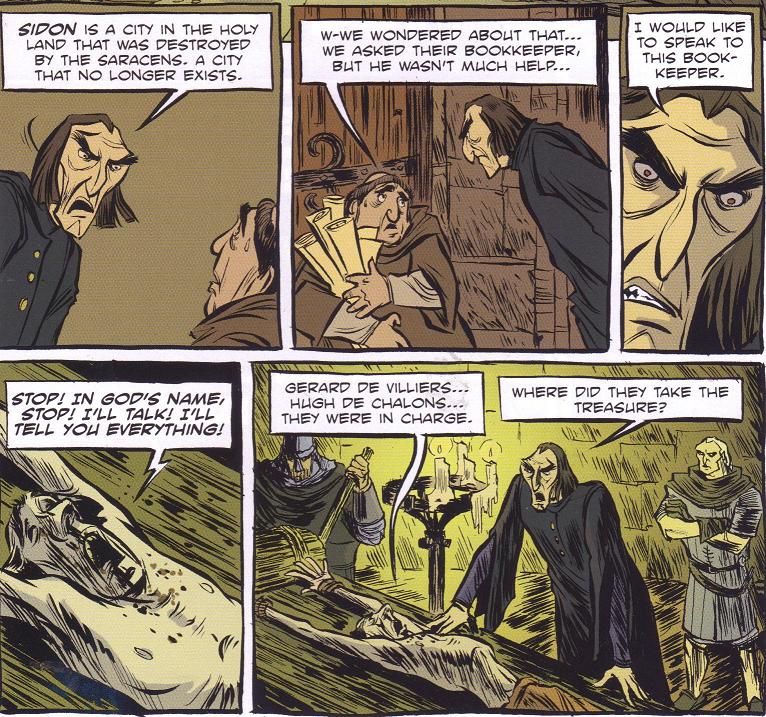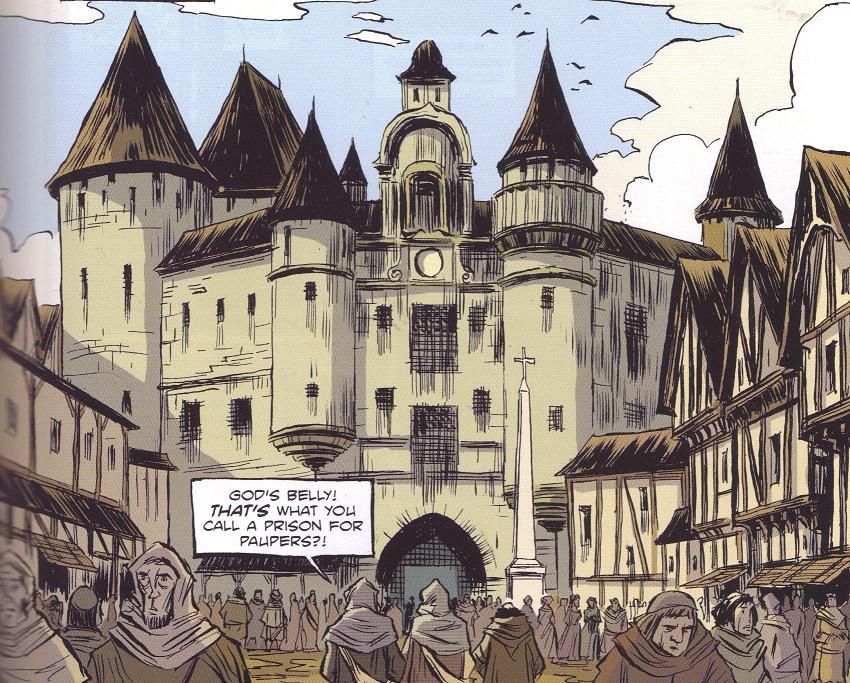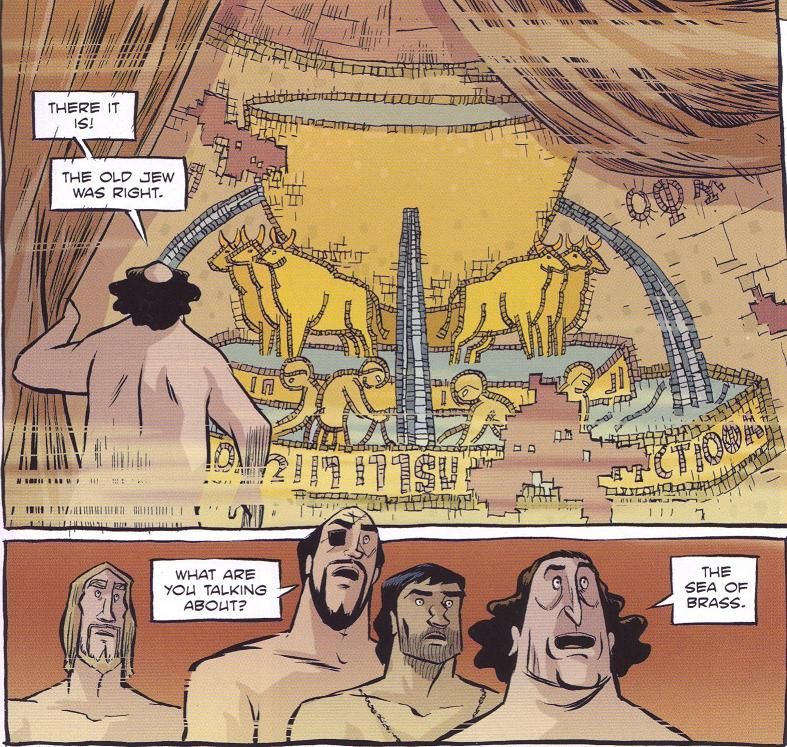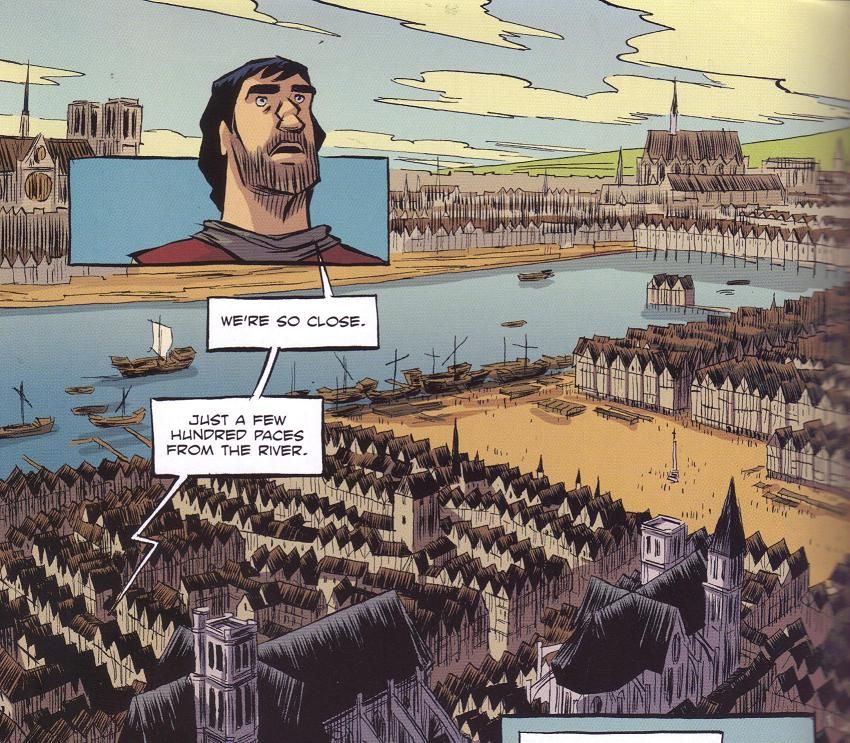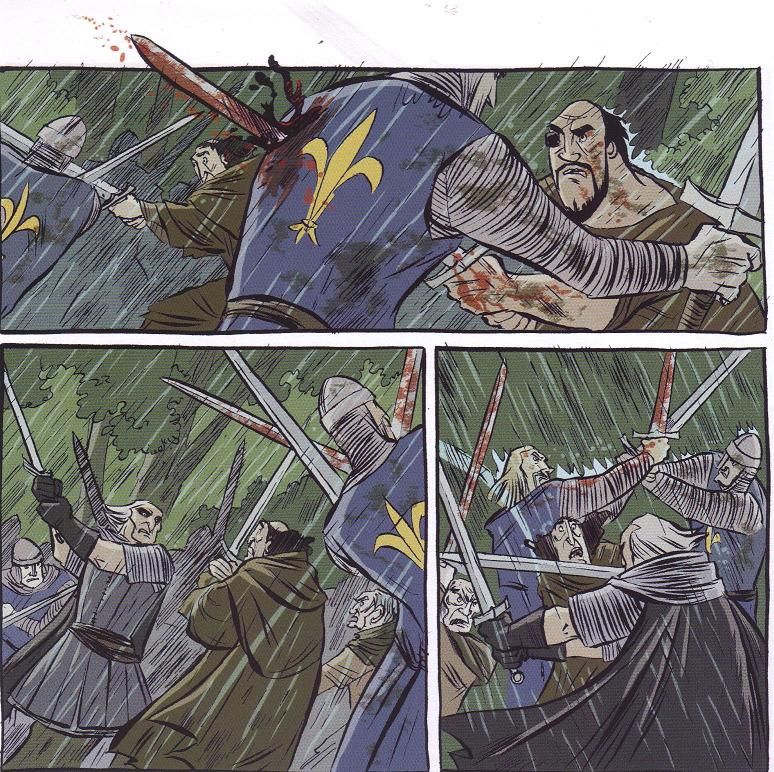"Love, if you're there come save me from all this cold despair; I can hang when you're around, but I'll surely die if you're not there"
Three years ago, I reviewed a comic called Solomon's Thieves, which was the first part of a trilogy. It's totally true! I really liked that book, but I worried about comics that come as trilogies, because who knows if you'll ever get the final two volumes?
As it turned out, I was right not to trust, because the second and third volumes never did come out, but this year, First Second finally published the entire epic. I guess it sucks for people like me who got the first volume, but that was a while ago, and all is forgiven, right? Anyway, Templar is written by Jordan Mechner, drawn by LeUyen Pham and Alex Puvilland, and colored by Hilary Sycamore and Alex Campbell. It costs $39.99, but it is 468 pages long, and First Second's presentation is always top-notch.
Mechner begins the book with the fall of Acre in 1291, which ended the Crusades, but that's just to give us a taste of what warfare was like during this time and also to add a bit of pathos to a scene later on, a scene which is tragic but not that crucial to the overall plot. He really begins in the book in October 1307, when the king of France, Philip IV ("le Bel"), decided to destroy the Templars. Mechner isn't that interested in why Philip does this - he alludes to Philip's money problems, which were pretty severe, and the Templars were rumored to have amassed a giant treasury that Philip couldn't tax, so he went after them (the Templars functioned as early bankers in the nascent capitalist economy of Europe, so it's not like they were destitute), seizing all their assets to fight his wars. Mechner also implies that the pope, Clement V, could have stopped the persecution if he could, but Clement (who never appears in the book) was a weak French puppet and probably colluded with Philip in the suppression of the order. Maybe the bishops who form the commission to examine the Templars really believed that the pope would back them up, but history tells us otherwise. Mechner, however, does a pretty good job with the basics of history - Philip did need money, although he may have believed the Templars were guilty of all the heretical charges leveled against them (religion and politics were inseparable back then, and someone with a realpolitik motive for something might also completely believe in more esoteric motives), his chancellor, Guillaume de Nogaret, was a bit of a hard-ass, and many Templars did confess to the crimes ascribed to them, although who knows if they confessed because they actually committed them or because they thought it would save their skins (or souls).
He provides a good backdrop to the main plot, which focuses on some wayward Templars and their attempts to steal the giant Templar treasure from under the nose of the king and his chancellor.
Mechner doesn't get into any weird stuff with regard to the Templars. This is not a book about connections to Jesus and the Holy Grail and a massive, millennia-spanning conspiracy. It's about the actual gold, silver, and jewels the Templars acquired over the two hundred years of their existence, and nothing more. Basically, this is a heist comic set in the 14th century. His main character, Martin of Troyes, is a simple Templar knight who, along with two of his friends, happens to miss getting swept up in the king's net when the other knights are arrested. Martin drinks a bit too much and pines away for Isabelle, a woman he planned to marry 12 years earlier but who married someone else. (Strangely enough, her husband is mentioned once early on, and then never again. I wonder if Mechner forgot about him.) He sees her again in Paris and tries to rekindle their romance, and that keeps him away from the temple on the night when they're arrested. Martin is eventually betrayed and captured, but he manages to escape and get out of the city. Eventually, he meets a priest who used to be a Templar and Bernard, another knight who escaped, and they persuade him to return to Paris and steal the treasure. The priest has a letter that explains how they can do it, and Martin eventually agrees.
The machinations of the plot take up the final two-thirds of the book. Isabelle is the sister of the Archbishop of Narbonne, who sits on the papal commission to determine the innocence or guilt of the Templars, so she is well placed to know what's going on.
Martin does meet her again, but she is still hurt that he left her, while he is angry that she married someone else. However, she does get some crucial information for him as they try to figure out where the treasure actually is. Mechner does a nice job leading us from one clue to another, as the three men have to keep one step ahead of the authorities but also need to figure out what the letter about the treasure actually means. Nogaret and his captain figure out they're in the city, and Nogaret realizes they're after the treasure, which he believed had been spirited out of the city on the night of the arrests. So he's looking for it, too, and Martin, Bernard, and the priest have to contend with that. They're joined by Martin's two friends, Odo and Von Berg, and eventually a Saracen named Salim, who's a convert to Christianity. Then it just becomes a race against time to get the treasure and get out of the city. Mechner never forgets to check in with the trials, which adds a sense of impending doom to their quest. Nogaret and Philip are determined to destroy the order, and they use every means at their disposal to do so. It's a good combination, because we know that if Martin is caught, he won't just go to jail, he'll be tortured and killed. It adds a lot of tension to the book as their plans unfold.
Mechner does some things we expect, and because he has a lot of room, he's able to get into a lot of different areas of medieval life and show how Martin and his gang are able to steal the treasure. The fact that this society was so stratified and oppressive works both for and against the thieves - the upper classes simply didn't notice the masses, so Martin and his group can go about in basic disguises and no one "sees" them. Mechner also uses the facts of life in medieval times to his advantage - part of Martin's plan relies on waste disposal, which was a huge problem in the days before electricity. He also gets into the fear so many people in this time lived under - a few words about heresy could ruin someone, and those in power used that leverage to their advantage. People had to be very careful, because everyone could be an informer. However, the means to eavesdrop were much more rudimentary than today - Europe's first spy agency was probably Elizabeth's almost 300 years later - so people could move around with relative freedom as long as they knew what they were doing.
This also comes into play during the book, as Martin and the others take advantage of both that freedom and people's basic instinct to not ask questions. What makes the book work is that Mechner is never too blatant about this - it's just the way society works in 1307.
The book is thrilling, too, as the heist goes off with some hitches that the gang has to overcome and then, of course, we get their escape, which doesn't go as planned at all. There's a lot of violence (not too graphic, but still somewhat bloody) and people get killed, but Mechner keeps us on our toes, as we're not sure who will make it out alive. What's very cool about the book is that the characters, especially Martin, take the Templar oath very seriously, so we never stray too far from one of the tenets of the comic, which is that people have to stand up to tyranny. Even when the book is clearly about a heist, Mechner works this theme into the plot, and it pays off very well at the end.
Pham and Puvilland, who are wife and husband, handle the artwork, and it works very well. They get the physical layout of Paris down very well, and we get a good sense of how the city looked, from the cramped neighborhoods where the lower classes lived to the magnificent palaces of the aristocracy. There are some beautiful long shots of the city, showing exactly how compact parts of it were, and how close together everyone lived. As Mechner makes human waste such a big part of the story, Pham and Puvilland show us how these operations worked and why everything was so filthy back in the Middle Ages. They're also quite good at the end, when they need to draw a lot of action - again, there's bloodshed, but it's not too gory. Pham and Puvilland, however, make it clear how brutal fighting with heavy swords was. They also do a very good job with the many characters in the book. They make Martin and the others nice and ragged, as they don't have access to good clothing, while Isabelle and the other aristocrats dress in finery that befits their station. We see the way medieval life beats people down, though, as many characters, even the rich, are gaunt and hard, showing how difficult their lives are - life was not for the weak in the 14th century. Sycamore, who's a tremendous colorist, does a fine job here, especially when the group does any work underground - Pham and Puvilland create a good, cramped environment, and Sycamore colors it with dark reds and yellows surrounded by black, showing a world lit only by flame.
There are a few double-page spreads, including a horrifying image, that are powerful both because of the way the artists draw them but also because Sycamore colors them. This is a world with very little non-natural light, so Sycamore gives us bright greens in the forest and achingly beautiful sunsets even as the city below is often smeared with ugliness.
I enjoyed the first volume of Templar when it was called Solomon's Thieves, but having the entire epic between two covers is great, because Mechner does such a good job blending history with the treasure quest and making all the characters feel like they have so much at stake. He manages to make Nogaret an interesting villain and even shows how tortured a douche like Philip could be when he allowed his conscience to pray on him. The mechanics of the heist and the getaway are tremendous, and the book ends in a way that works even if you see it coming (which I didn't, but that's probably because I don't really think about it too much). It's an exciting comic, but it also has a lot of interesting social commentary in it, and it works so well because the characters are so vibrant. Give it a look - I don't think you'll be disappointed.
Rating: ★ ★ ★ ★ ★ ★ ★ ★ ½ ☆

